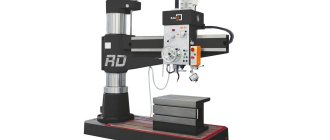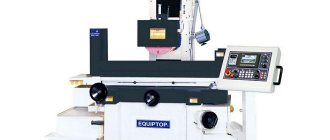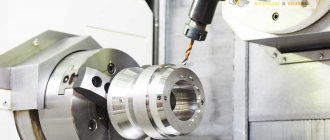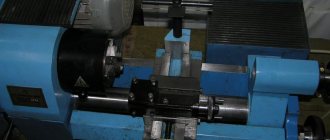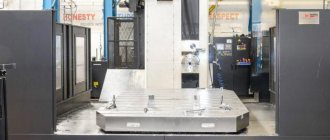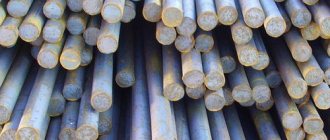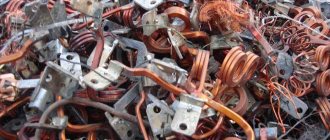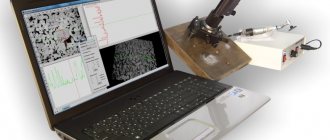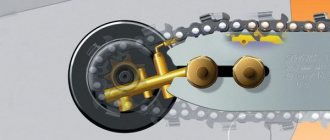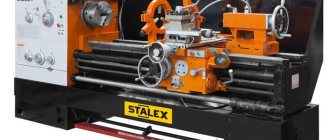Metal products are used in various industries. Parts of different shapes are installed in factory equipment, cars, airplanes, and ships. However, it is extremely difficult to make similar products by hand. The lathe plays an important role in the metalworking process. With its help, a master can create a part from a rough blank into the required shape and put it into further production.
Working on a lathe
What is a lathe?
To understand what a lathe is, you need to understand what this equipment consists of and how to operate it correctly. Knowing the technical specifications makes it easier to choose the right model.
Lathes are industrial equipment that can be used for processing various types of metal and wood. With the help of such machines it is possible to produce parts of various shapes. These can be metal rings, pulleys, bushings, couplings, nuts and shafts. Lathe equipment is often used to create special grooves on workpieces. With its help, parts of the part are cut off, finished holes are processed and threads are created.
Classification, groups, types and types of metal-cutting machines.
Classification of metal-cutting machines by groups, subgroups and types, by accuracy class, by degree of automation and specialization and weight.
Classification of metal-cutting machines by type of processing, adopted by ENIMS
Table of groups and types of metal-cutting machines
Classification of metal-cutting machines by accuracy class
Classification of metal-cutting machines by degree of automation
Classification of metal-cutting machines by degree of specialization
Classification of metal-cutting machines by weight
History of the appearance and development of equipment
It is believed that the first lathes appeared in Europe in the 16-17th century. In those days, they were made of wooden elements and driven by human efforts. He could spin the movable wheel with his hands or then rotate the chain attached to the sprocket.
Turning production did not receive active development until the 18th century. Only in the first part of the 18th century did metal mechanisms begin to be actively used in industry. By the second half of the 19th century, through the efforts of American craftsmen, the equipment was modernized and already resembled a modern lathe. The mechanism worked thanks to an electric motor, and it became possible to choose the spindle speed.
Principle of operation
Turning production is common in various industries. With the help of such machines, various parts for machines, equipment, household appliances, and construction are manufactured. The operating principle of the lathe is simple:
- The technician checks the serviceability of all mechanisms and fasteners.
- Fixes the workpiece on a movable carriage.
- Installs the required cutter into the chuck, which is mounted on the spindles.
- After the engine starts, the spindle begins to rotate and transmits rotational energy to the cutter. She, in turn, removes the required layer of metal from the workpiece.
If you need to make a hole, the master installs another cutter in the chuck and starts drilling.
How does a lathe work and what does it consist of?
The design of all installations includes the following components:
- ● Bed. This is a metal base that supports the entire weight of the remaining elements, as well as the workpiece. All other parts are also attached to it.
- ● Apron. Responsible for converting energy into movement.
- ● Grandmas. There are two of them - one is simply responsible for fixing, the other includes a motor and a spindle that holds and simultaneously rotates the workpiece.
- ● Support. He is responsible for the tool - its movement and fixation.
- ● Feed box and other elements that allow you to change the speed and direction of movement of moving units.
- ● Numerical control panel, which, in turn, includes a display, a cabinet with buttons and the program itself.
These are the main parts, but there are also additional systems, for example, the supply of lubricating and cooling fluid or the removal of chips.
Basic parameters of a lathe
When choosing a metal lathe, you need to take into account its main characteristics. They are indicated in the technical data sheet of the equipment. You need to pay attention to the following parameters:
- Control Panel. Budget models may not have a spindle speed controller.
- Machine weight. When the electric motor operates and the cutter spins, powerful vibrations are created. The more powerful the engine, the heavier the machine should be. Industrial equipment is equipped with cast frames that dampen vibrations and prevent the machine from moving during operation.
- Dimensions. This option must be selected based on the available space in the room. Industrial equipment is more than garage or workshop models.
- Drive power. The harder the metal will be processed, the more powerful the equipment you need to buy.
- Nutrition. For low-power models - 220 volts, for industrial machines - 380 volts.
- Workpiece size. The more parts a lathe can machine, the more versatile it becomes.
Also, in different models, reverse may or may not be present. Its switching is carried out using levers or throwing the belt.
Lathe with control panel
Technical and technological indicators of turning machines
1.12.5. Technical and technological indicators of turning machines
- Basic operating conditions
- Dimensions of the working space for placing workpieces, tools and fixtures.
- The location of the surfaces to be processed, their number and dimensions.
- The largest mass of installed workpieces and methods of fastening.
- Limits of rotation speeds and feeds of working bodies
- The basic shape of the workpieces being processed (determines the spatial placement of the working parts of the machine).
- Number, shape and parameters of installed tools for standard processing methods.
- Number of controlled (including simultaneous) movements of working bodies.
- Discreteness of movement along coordinate axes
- Main drive and feed power.
- Number of transitions and passes.
- Speeds of idle and installation movements.
- The same working movements.
- Availability of automation of main and auxiliary cycles.
- Equipped with additional accessories and devices.
- Number of simultaneously processed workpieces and installed tools
- Output accuracy of the machine.
- Accuracy of product installation and stability of positioning of working parts.
- Initial workpiece accuracy and volumetric quality stability.
- Dimensional wear resistance of the tool.
- Static, dynamic and thermal deformations of the supporting system, groups of workpiece units and tools.
- Possibility of correcting the movements of forming elements.
- Character of wear of machine elements and components
- Machine weight.
- The area occupied by the machine.
- Reliability of systems and components.
- Specific energy intensity.
- Material consumption.
- Technical and operational safety and efficiency.
- Ease of management and maintenance.
- Maintainability
Where are lathes used?
The importance of the lathe in metalworking is not exaggerated. Not a single serious production can operate without such equipment. With it you can perform the following operations:
- various types of drilling;
- carving creation;
- trimming and turning the ends of parts;
- creation of cylindrical and cone-shaped parts;
- countersinking;
- milling.
Lathes are used in metallurgy, automotive industry, shipbuilding, aircraft manufacturing, and the manufacture of parts for industrial equipment.
Classification
Metal-cutting machines, depending on the nature of the work performed and the type of cutting tools used, are divided into 11 groups (see figure).
- The group of lathes (items 1 – 6) consists of machines designed for processing rotating surfaces. The unifying feature of the machines of this group is the use of the rotational movement of the workpiece as a cutting movement.
- The group of drilling machines (items 7 – 10) also includes boring machines. The unifying feature of this group of machines is their purpose - processing round holes. The cutting movement is the rotational movement of the tool, which is usually also accompanied by a feed movement. In horizontal boring machines, feed can also be carried out by moving the table with the workpiece.
- The group of grinding machines (items 20 – 24) is united on the basis of the use of abrasive grinding wheels as a cutting tool.
- The group of polishing and finishing machines is united on the basis of the use of abrasive bars, abrasive belts, powders and pastes as cutting tools.
- The group of gear-processing machines includes all machines that are used for processing wheel teeth, including grinding machines.
- The group of milling machines (items 11 – 14) consists of machines that use multi-blade tools - cutters - as cutting tools.
- The group of planing machines (items 15 – 17) consists of machines whose common feature is the use of a rectilinear reciprocating movement of the cutter or workpiece as a cutting movement.
- The group of cutting machines includes all types of machines designed for cutting and sawing rolled materials (rods, angles, channels, etc.).
- The group of broaching machines (lines 18 and 19) has one common feature: the use of special multi-bladed tools—broaches—as a cutting tool.
- The group of thread-processing machines includes all machines (except for turning machines) designed specifically for the production of threads.
- The group of miscellaneous and auxiliary machines combines all machines that do not belong to any of the groups listed above.
Read also: How to properly connect a radio in a car
Types of machines
Today there are many types of lathes. Each of them differs in its characteristics, functionality, control system and design.
Types of turning equipment:
- Screw-cutting lathes. They are considered the most common machines. Used for the manufacture of single parts and mass production. With their help, you can make threads on the outer and inner sides of workpieces, grind cylindrical and cone-shaped workpieces, and process ends. Screw-cutting models allow the master to create holes of various diameters, carry out countersinking and reaming. If you have a copying device, it becomes possible to create complex contours without shaped cutters.
- Drilling. A large group of equipment, which includes a vertical lathe, radial, single-spindle, multi-spindle and horizontal. With the help of such machines, holes of different diameters are drilled and threads are created. When choosing drilling machines, you need to pay attention to the spindle stroke, the power of the electric motor, the distance from the work table to the chuck, and the maximum diameter of the holes created.
- Boring. Multifunctional equipment that allows you to create holes in workpieces, cut threads with swords, create grooves on the surface of parts, countersink and boring holes. Diamond boring machines are used for precision machining.
- Grinding. Machines on which discs with replaceable grinding wheels are installed. With their help, parts of various shapes are processed from the outside and inside. Additionally, you can cut workpieces and sharpen cutting tools. The quality of processing depends on the grain size of the grinding wheel. Coarse layers of metal are removed from the workpiece in large fractions. The fine fraction is intended for finishing grinding.
- Lapping. Special laps are installed on the working part, on the surface of which abrasive powder is applied.
- Honing. A special head (honon) is attached to the spindle of such machines, which consists of bars with the application of abrasive powder. The working part rotates and moves in two directions, processing a fixed hole in the workpiece.
- Gear processing. Many shaped cutters are installed on such equipment.
Also, we must not forget about thread-processing and milling equipment. They are used for making holes, threading, facing, and creating parts of various shapes. In stores you can see universal CNC lathes. This is a versatile piece of equipment that can perform a variety of tasks. After the operator configures the program, the system itself begins to work.
Lathe and drilling machine
Work performed on turning equipment
There are the following main types of work performed on turning equipment:
- processing of cylindrical surfaces;
- processing of conical parts such as shaft;
- design of complex surfaces of bodies of revolution, shaped turning, turning fillets and roundings;
- trimming of workpieces, processing of ledges;
- turning grooves (external and internal);
- drilling, boring, reaming, countersinking holes; cutting internal and external threads using cutters and other tools - taps, threading heads;
- cutting of workpieces.
Lathe device
There are several basic parts of a lathe. Each of them influences the work of the others. In addition to key components, various accessories for lathes can be installed on the equipment.
bed
To keep the machine stationary during operation, all parts are secured to a heavy frame. It consists of two vertical ribs that are fixed to a fixed base. At the bottom of the base there can be compartments for storing tools and accessories. Transverse rails are attached to the upper part, along which the calipers and tailstock (carriage) move.
Headstock
This part contains a spindle with a chuck, bearings and a machine control system. Inside there are movable gears through which rotational force is transmitted to the cutter.
Tailstock
It is a movable unit of the machine. The tailstock is used to secure the workpiece to the spindle. Consists of two parts. The lower one is considered motionless and plays the role of the base. The upper one moves along a shaft that runs inside the tailstock.
Caliper
Cutters and various turning tools are attached to the top of the support. The support is a moving element. If you set the center point of the machine, this part moves in four directions, processing the workpiece.
Turret lathes
Turret lathes (see Fig. 11.14) are designed for the manufacture of complex-shaped parts from rods and piece workpieces that require sequential processing of various operations. They differ from turning-screw-cutting ones in the absence of a tailstock, instead of which a turret caliper is installed, and a turret head of a vertical, horizontal or inclined arrangement is mounted on it. Turret machines do not have lead screws. In the sockets of the turret head you can simultaneously fix cutters, drills, countersinks, reamers, taps, dies, etc.
In turret machines, clamping, bar feeding and slide movement are usually mechanized. Modern machines (see Fig. 11.16) have a significant level of automation and functionality. It is most rational to use them in mass production.
Which metal lathe to buy: recommendations for choosing
To make the most of your investment, you need to know how to choose a lathe. Small-sized equipment with low power is suitable for a home workshop or garage. Recommendations for selection:
- Machine power supply. For home use, it is better to choose a model that can be connected to a 220 volt network.
- Spindle speed adjustment available. It is desirable that this function be present in the selected model.
- Weight up to 80 kg. This weight will be enough to keep the machine stationary while processing workpieces. Such machines can be moved around the workshop independently.
- Dimensions. The dimensions of the equipment should be less than the free space in the room. It is important to leave space for unobstructed access to any part of the machine.
- Availability of a guarantee and the ability to return the machine for service if it breaks down.
- Cast frame. It must be made of durable materials to withstand constant loads.
To find out the structure of the equipment, you can look at the diagram of the lathe. It will indicate key components, connecting elements and mechanisms for configuration.
Small dimensions of the machine
The most popular machine models
For their own use, home craftsmen choose metal lathes from the manufacturers JET and OPTIMUM. These companies are considered the most popular in terms of price and quality. They produce models both for their own workshops and for factories. The average price for JET equipment reaches 150,000 rubles. On average, you will have to pay about 250,000 rubles for a machine from OPTIMUM.
Woodworking machines
Modern manufacturers offer a wide selection of woodworking machines. General-purpose installations, special models for the production of similar parts, or specialized devices for certain types of wood processing are produced.
To ensure that the equipment fully meets your expectations after purchase, we suggest using the following tips.
- Optimal power depends on the characteristics of the work and the list of operations that will be performed on the selected machine. Household models are considered to be models with a power of up to 3 kW/h, connected to a 220 V network; industrial models are units with higher productivity, which are also distinguished by a greater depth of cut, planing width, and a wider range of functions.
- The bed should be heavy and rigid (cast iron would be the ideal material for its manufacture).
- It is desirable to have a chuck on the headstock or the ability to install it. In the future, this will make it possible to process workpieces that are secured at only one end.
- The ability to install a drill chuck on the tailstock, which will greatly facilitate the task of sharpening blind holes.
- The presence of a spindle speed controller is a convenient feature that will help improve the quality of many technological operations.
- Universal models are equipped with a saw blade, drill, milling cutter, planing shaft with 3 or 4 knives.
Features of working on a metal lathe
To create high-quality products on a lathe, you need to take into account some features and recommendations of experienced craftsmen. Tips for use and maintenance:
- Before starting work, you need to check the fastenings of the main parts, cutters and workpiece. They should not move when touched. It is also important to pay attention to the initial setup.
- It is not recommended to place foreign objects or tools on the bed.
- After turning off the machine, the working surface and cutters must be blown using a compressor.
- Moving elements must be lubricated to prevent jams.
- When working with workpieces, you must wear safety glasses to avoid getting chips in your eyes.
After completing the work, you need to clean the machine from accumulated dirt and production waste.
Do not work with damaged cutters, drills and cutters. CNC machines require constant diagnostics. People with programming experience can work behind them. The operator sets up a program according to the algorithm of which the moving elements will move and the engines will operate. Lathes are key equipment in various types of production. With their help, you can perform a number of operations that make human work easier.
Features of the CNC block device
As previously noted, most often a turret lathe has components that can operate from a CNC unit. This is due to the fact that CNC provides high productivity.
CNC Turret Lathe
Among the features of modern models, we note the following points:
- Often, workpieces are processed under a protective casing. This feature eliminates the possibility of injury during operation of such machines. A protective casing is used because all components are controlled by a CNC unit.
- When installing the appropriate equipment and cutting tools, processing can be carried out with high precision. In this case, the probability of error is very small. An example is that the cutters installed must have a wear-resistant cutting edge, which has recently been manufactured in the form of plates.
- The fact that to perform various operations it is not necessary to manually change the cutting tool determines a significant reduction in the time required to obtain the part.
- Increasing productivity can significantly reduce the cost of manufactured parts.
However, repairing a CNC turret lathe causes quite a lot of difficulties. Therefore, it is necessary to carry out timely maintenance to reduce the likelihood of serious problems with the equipment.
Many turners are familiar with such models as 1341, 1P365, 1P731, S193A. All these models are widely installed in machine shops. Improvements in computers have led to the emergence of more modern and efficient models. High automation of work allows increasing accuracy and increasing the quality of products. So popular models include the 1V340F30 and 1P426DF3 machines. These machines have multifunctional control units, the cutting area is covered with a protective casing. The layout is significantly different from those used to create earlier models.
Read also: Surface roughness is measured along a length called
In conclusion, we note that even repairing a turret lathe without a CNC unit causes quite a lot of difficulties due to the complexity of the turret head design. Repair of a turret lathe, which was manufactured during the existence of the USSR, is complicated by the lack of required spare parts. Of course, you can make them yourself, but this poses serious difficulties.
If you find an error, please select a piece of text and press Ctrl+Enter.
A turret lathe is a subtype of a lathe and is designed for processing wood, metal and other workpieces using rotational force. A classic turret lathe uses one chuck to hold the part and one holder for the cutter.
In this case, the part is transmitted not only longitudinal movement around its axis, but also circular movement. Thanks to this feature, turret lathes are considered universal - they can handle the entire range of work that other types of lathes are capable of.
